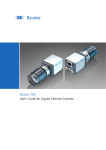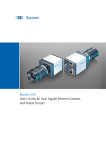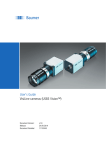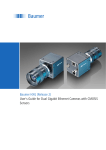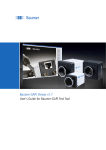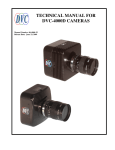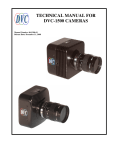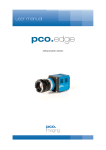Download Baumer TXG User's Guide for Gigabit Ethernet
Transcript
Baumer TXG User's Guide for Gigabit Ethernet Cameras Document Version: v4.7 Release: 11.11.2014 Document Number: 11037655 2 Table of Contents 1.Portfolio��������������������������������������������������������������������������������������������������������������������� 6 1.1 Standard Cameras�������������������������������������������������������������������������������������������������� 7 1.2 Standard Cameras with Power over Ethernet (PoE)���������������������������������������������� 8 1.3 Standard Cameras with 3 In- and 3 Outputs����������������������������������������������������������� 9 1.4 IP67 Cameras������������������������������������������������������������������������������������������������������� 10 1.4.1 Protective Caps�����������������������������������������������������������������������������������������������11 1.4.2 Maximal Objective Length inside Protective Cap��������������������������������������������11 1.4.3 Determination of the Required Tube Length�������������������������������������������������� 12 2. Product Specifications������������������������������������������������������������������������������������������ 16 2.1 Spectral Sensitivity for Baumer TXG Cameras����������������������������������������������������� 16 2.2 Field of View Position�������������������������������������������������������������������������������������������� 19 2.2.1 Standard Cameras����������������������������������������������������������������������������������������� 19 2.2.2 Cameras with IP67 Housing��������������������������������������������������������������������������� 20 2.3 Process- and Data Interfaces������������������������������������������������������������������������������� 21 2.3.1 Interfaces of Camera Types��������������������������������������������������������������������������� 21 2.3.2 Pin-Assignment���������������������������������������������������������������������������������������������� 21 2.3.3 LEDs of Camera Types���������������������������������������������������������������������������������� 23 2.4 Acquisition Modes and Timings����������������������������������������������������������������������������� 23 2.4.1 Free Running Mode���������������������������������������������������������������������������������������� 24 2.4.2 Fixed-Frame-Rate Mode�������������������������������������������������������������������������������� 24 2.4.3 Trigger Mode�������������������������������������������������������������������������������������������������� 25 2.4.4 Advanced Timings for GigE Vision® Message Channel���������������������������������� 29 2.5 Environmental Requirements�������������������������������������������������������������������������������� 31 2.5.1 Temperature and Humidity Range������������������������������������������������������������������ 31 2.5.2 Heat Transmission������������������������������������������������������������������������������������������ 31 3. Software������������������������������������������������������������������������������������������������������������������ 32 3.1 Baumer GAPI�������������������������������������������������������������������������������������������������������� 32 3.2 3rd Party Software�������������������������������������������������������������������������������������������������� 32 4. Camera Functionalities������������������������������������������������������������������������������������������ 33 4.1 Image Acquisition�������������������������������������������������������������������������������������������������� 33 4.1.1 Image Format������������������������������������������������������������������������������������������������� 33 4.1.2 Pixel Format��������������������������������������������������������������������������������������������������� 34 4.1.3 Exposure Time����������������������������������������������������������������������������������������������� 37 4.1.4 Look-Up-Table������������������������������������������������������������������������������������������������ 38 4.1.5 Gamma Correction����������������������������������������������������������������������������������������� 38 4.1.6 Region of Interest (ROI)��������������������������������������������������������������������������������� 39 4.1.7 Binning����������������������������������������������������������������������������������������������������������� 40 4.1.8 Brightness Correction (Binning Correction)���������������������������������������������������� 41 4.1.9 Fast Mode������������������������������������������������������������������������������������������������������ 41 4.1.10 HQ Mode������������������������������������������������������������������������������������������������������ 41 4.2 Color Processing��������������������������������������������������������������������������������������������������� 42 4.3 Color Adjustment – White Balance����������������������������������������������������������������������� 42 4.3.1 User-specific Color Adjustment���������������������������������������������������������������������� 42 4.3.2 One Push White Balance������������������������������������������������������������������������������� 43 3 4.4 Analog Controls����������������������������������������������������������������������������������������������������� 43 4.4.1 Offset / Black Level����������������������������������������������������������������������������������������� 43 4.4.2 Gain���������������������������������������������������������������������������������������������������������������� 44 4.5 Pixel Correction����������������������������������������������������������������������������������������������������� 44 4.5.1 General information���������������������������������������������������������������������������������������� 44 4.5.2 Correction Algorithm��������������������������������������������������������������������������������������� 45 4.5.3 Defectpixellist������������������������������������������������������������������������������������������������� 45 4.6 Process Interface�������������������������������������������������������������������������������������������������� 46 4.6.1 Digital IOs������������������������������������������������������������������������������������������������������� 46 4.6.2 IO Circuits������������������������������������������������������������������������������������������������������� 48 4.6.3 Trigger������������������������������������������������������������������������������������������������������������ 49 4.6.4 Trigger Source������������������������������������������������������������������������������������������������ 49 4.6.5 Debouncer������������������������������������������������������������������������������������������������������ 50 4.6.6 Flash Signal���������������������������������������������������������������������������������������������������� 50 4.6.7 Timers������������������������������������������������������������������������������������������������������������� 51 4.6.8 Frame Counter����������������������������������������������������������������������������������������������� 52 4.7 Sequencer������������������������������������������������������������������������������������������������������������� 53 4.7.1 General Information���������������������������������������������������������������������������������������� 53 4.7.2 Baumer Optronic Sequencer in Camera xml-file�������������������������������������������� 54 4.7.3 Sequencer Modes������������������������������������������������������������������������������������������ 54 4.7.4 Modality���������������������������������������������������������������������������������������������������������� 54 4.7.5 Examples�������������������������������������������������������������������������������������������������������� 55 4.7.6 Capability Characteristics of Baumer-GAPI Sequencer Module�������������������� 55 4.7.7 Double Shutter����������������������������������������������������������������������������������������������� 56 4.8 User Sets�������������������������������������������������������������������������������������������������������������� 57 4.9 Factory Settings���������������������������������������������������������������������������������������������������� 57 4.10 Timestamp���������������������������������������������������������������������������������������������������������� 57 5. Interface Functionalities���������������������������������������������������������������������������������������� 58 5.1 Device Information������������������������������������������������������������������������������������������������ 58 5.2 Packet Size and Maximum Transmission Unit (MTU)������������������������������������������� 58 5.3 Inter Packet Gap��������������������������������������������������������������������������������������������������� 58 5.3.1 Example 1: Multi Camera Operation – Minimal IPG��������������������������������������� 59 5.3.2 Example 2: Multi Camera Operation – Optimal IPG��������������������������������������� 59 5.4 Transmission Delay����������������������������������������������������������������������������������������������� 60 5.4.1 Time Saving in Multi-Camera Operation�������������������������������������������������������� 60 5.4.2 Configuration Example����������������������������������������������������������������������������������� 61 5.5 Multicast���������������������������������������������������������������������������������������������������������������� 63 5.6 IP Configuration���������������������������������������������������������������������������������������������������� 64 5.6.1 Persistent IP��������������������������������������������������������������������������������������������������� 64 5.6.2 DHCP (Dynamic Host Configuration Protocol)����������������������������������������������� 64 5.6.3 LLA����������������������������������������������������������������������������������������������������������������� 65 5.6.4 Force IP���������������������������������������������������������������������������������������������������������� 65 5.7 Packet Resend������������������������������������������������������������������������������������������������������ 66 5.7.1 Normal Case�������������������������������������������������������������������������������������������������� 66 5.7.2 Fault 1: Lost Packet within Data Stream�������������������������������������������������������� 66 5.7.3 Fault 2: Lost Packet at the End of the Data Stream��������������������������������������� 66 5.7.4 Termination Conditions����������������������������������������������������������������������������������� 67 5.8 Message Channel������������������������������������������������������������������������������������������������� 68 5.8.1 Event Generation������������������������������������������������������������������������������������������� 68 5.9 Action Command / Trigger over Ethernet�������������������������������������������������������������� 69 5.9.1 Example: Triggering Multiple Cameras���������������������������������������������������������� 69 4 6. Start-Stop-Behaviour��������������������������������������������������������������������������������������������� 70 6.1 Start / Stop Acquisition (Camera)�������������������������������������������������������������������������� 70 6.2 Start / Stop Interface��������������������������������������������������������������������������������������������� 70 6.3 Pause / Resume Interface������������������������������������������������������������������������������������ 70 6.4 Acquisition Modes������������������������������������������������������������������������������������������������� 70 6.4.1 Free Running�������������������������������������������������������������������������������������������������� 70 6.4.2 Trigger������������������������������������������������������������������������������������������������������������ 70 6.4.3 Sequencer������������������������������������������������������������������������������������������������������ 70 7. Lens Mounting�������������������������������������������������������������������������������������������������������� 71 8. Cleaning (Cover glass/Housing)��������������������������������������������������������������������������� 71 9. Disposal������������������������������������������������������������������������������������������������������������������ 73 10.Warranty Notes������������������������������������������������������������������������������������������������������� 73 11.Transport / Storage������������������������������������������������������������������������������������������������ 73 12.Conformity�������������������������������������������������������������������������������������������������������������� 74 12.1 CE����������������������������������������������������������������������������������������������������������������������� 74 12.2 FCC – Class B Device���������������������������������������������������������������������������������������� 74 12.3 UL – Class III Device������������������������������������������������������������������������������������������� 74 13.Support�������������������������������������������������������������������������������������������������������������������� 75 5 1. Portfolio All Baumer Gigabit Ethernet cameras of the TXG family are characterized by: 6 Best image quality ▪▪ High-quality progressive scan CCD sensors with highest sensitivity ▪▪ Image output data in 8 / 10 / 12 bit resolution ▪▪ Low noise and structure-free image information ▪▪ High quality mode with minimum noise Flexible image acquisition ▪▪ Exposure times from 4 μs to 60.000 ms ▪▪ Binning and true partial scan readout modes ▪▪ Industrially compliant process interface with parameter setting capability (trigger and flash) Fast image transfer ▪▪ Reliable transmission at 1000 Mbit/sec according to IEEE802.3 ▪▪ Cable length up to 100 m ▪▪ Baumer driver for high data volume with low CPU load ▪▪ High-speed multi-camera operation ▪▪ Gen<I>Cam™ and GigE Vision® compliant Perfect integration ▪▪ Flexible generic programming interface (BaumerGAPI) for all Baumer cameras ▪▪ Powerful Software Development Kit (SDK) with sample codes and help files for simple integration ▪▪ Baumer viewer for all camera functions ▪▪ Interface for .NET ( C#, VB.NET), C and C++ ▪▪ Software for Windows® XP / Vista™ and Linux®, 32 bit and 64 bit ▪▪ Gen<I>Cam™ compliant XML file to describe the camera functions ▪▪ Supplied with installation program with automatic camera recognition for simple commissioning Compact design ▪▪ Rugged, industrial housing design ▪▪ Uniform dimensions (36 mm x 36 mm frontside) for all standard models ▪▪ Light weight Reliable operation ▪▪ State-of-the-art camera electronics and precision mechanics ▪▪ Low power consumption and minimal heat generation ▪▪ Long lifetime 2. Product Specifications 2.1 Spectral Sensitivity for Baumer TXG Cameras The spectral sensitivity characteristics of monochrome and color matrix sensors for Baumer Gigabit Ethernet cameras are displayed in the following graphs. The characteristic curves for the sensors do not take the characteristics of lenses and light sources without filters into consideration. Figure 12 ► Spectral sensitivities for Baumer cameras with 0.3 MP*) CCD sensor. 10 10 08 08 Relative Response Relative Response Values relating to the respective technical data sheets of SONY Corporation. 06 04 02 06 04 02 0 0 400 500 TXG02 600 700 800 900 1000 400 450 TXG02c Wave Length [nm] 500 550 600 650 700 650 700 650 700 Wave Length [nm] 10 08 08 06 04 16 04 0 0 400 500 TXG03 600 700 800 900 1000 400 450 TXG03c Wave Length [nm] 10 08 08 Relative Response 10 06 04 500 550 600 Wave Length [nm] 06 04 02 02 Figure 14 ► Spectral sensitivities for Baumer cameras with 0.3 MP CCD sensor. 06 02 02 Relative Response Figure 13 ► Spectral sensitivities for Baumer cameras with 0.3 MP CCD sensor. 10 Relative Response Relative Response *) MP = Megapixels 0 0 400 TXG04 500 600 700 800 Wave Length [nm] 900 1000 400 TXG04c 450 500 550 600 Wave Length [nm] 10 Relative Response 08 06 04 ◄ Figure 15 Spectral sensitivities for Baumer cameras with 0.3 MP Kodak CCD sensor. 02 0 400 500 800 900 1000 10 08 08 06 04 06 04 02 02 0 0 500 TXG06 600 700 800 900 1000 400 10 10 08 08 06 04 0 0 500 600 700 800 900 400 1000 10 08 08 Relative Response 10 06 04 0 0 500 600 700 800 Wave Length [nm] 900 1000 700 700 ◄ Figure 17 Spectral sensitivities for Baumer cameras with 0.8 MP CCD sensor. 450 500 550 600 650 Wave Length [nm] 04 02 400 650 06 02 TXG12 600 Wave Length [nm] TXG08c Wave Length [nm] 550 04 02 400 500 ◄ Figure 16 Spectral sensitivities for Baumer cameras with 0.6 MP CCD sensor. 06 02 TXG08 450 TXG06c Wave Length [nm] Relative Response Relative Response 700 Wave Length [nm] 10 400 Relative Response 600 Relative Response Relative Response TXG04h 400 TXG12c 450 500 550 600 Wave Length [nm] 650 700 ◄ Figure 18 Spectral sensitivities for Baumer cameras with 1,2 MP CCD sensor. 17 10 08 08 Relative Response Relative Response 10 06 04 0 0 400 500 700 800 900 400 1000 10 10 08 08 06 04 0 500 600 700 800 900 600 650 700 650 700 650 700 650 700 06 04 1000 400 450 TXG14c Wave Length [nm] 10 10 08 08 Relative Response Relative Response TXG14 06 04 500 550 600 Wave Length [nm] 06 04 02 0 0 400 500 TXG20 600 700 800 900 1000 400 450 TXG20c Wave Length [nm] 10 10 08 08 Relative Response Relative Response 18 550 Wave Length [nm] 0 400 06 04 02 Figure 22 ► Spectral sensitivities for Baumer cameras with 5.0 MP CCD sensor. 500 02 02 Figure 21 ► Spectral sensitivities for Baumer cameras with 2.0 MP CCD sensor. 450 TXG13c Wave Length [nm] Relative Response Relative Response TXG13 600 02 Figure 20 ► Spectral sensitivities for Baumer cameras with 1.4 MP CCD sensor. 04 02 02 Figure 19 ► Spectral sensitivities for Baumer cameras with 1.4 MP CCD sensor. 06 500 550 600 Wave Length [nm] 06 04 02 0 0 400 TXG50 500 600 700 800 Wave Length [nm] 900 1000 400 TXG50c 450 500 550 600 Wave Length [nm] 2.4.3.2 Overlapped Operation: texposure(n+2) > texposure(n+1) If the exposure time (texposure) is increased form the current acquisition to the next acquisition, the time the camera is unable to process occuring trigger signals (tnotready) is scaled down. This can be simulated with the formulas mentioned above (no. 2 or 4, as is the case). Trigger tmin ttriggerdelay Timings: A - exposure time frame (n) effective B - image parameters frame (n) effective C - exposure time frame (n+1) effective D - image parameters frame (n+1) effective E - earliest possible trigger Image parameters: Offset Gain Mode Partial Scan 26 Exposure texposure(n) treadout(n) Readout TriggerReady Flash texposure(n+1) treadout(n+1) tnotready tflash(n) tflashdelay texposure(n+2) tflash(n+1) 2.4.3.3 Overlapped Operation: texposure(n+2) < texposure(n+1) If the exposure time (texposure) is decreased from the current acquisition to the next acquisition, the time the camera is unable to process occuring trigger signals (tnotready) is scaled up. When decreasing the texposure such, that tnotready exceeds the pause between two incoming trigger signals, the camera is unable to process this trigger and the acquisition of the image will not start (the trigger will be skipped). Trigger tmin ttriggerdelay Exposure texposure(n) treadout(n) Readout TriggerReady Flash texposure(n+1) texposure(n+2 treadout(n+1) tnotready tflash(n) tflash(n+1) tflashdelay Timings: A - exposure time frame (n) effective B - image parameters frame (n) effective C - exposure time frame (n+1) effective D - image parameters frame (n+1) effective E - earliest possible trigger F - frame not started / trigger skipped Image parameters: Offset Gain Mode Partial Scan Notice From a certain frequency of the trigger signal, skipping triggers is unavoidable. In general, this frequency depends on the combination of exposure and readout times. 27 2.4.3.4 Non-overlapped Operation If the frequency of the trigger signal is selected for long enough, so that the image acquisitions (texposure + treadout) run successively, the camera operates non-overlapped. Trigger tmin ttriggerdelay Timings: A - exposure time frame (n) effective B - image parameters frame (n) effective C - exposure time frame (n+1) effective D - image parameters frame (n+1) effective E - earliest possible trigger Image parameters: Offset Gain Mode Partial Scan 28 Exposure texposure(n) treadout(n) Readout TriggerReady Flash texposure(n+1) treadout(n+1) tnotready tflash(n) tflashdelay tflash(n+1) 2.4.4 Advanced Timings for GigE Vision® Message Channel The following charts show some timings for the event signaling by the asynchronous message channel. Vendor-specific events like "TriggerReady", "TriggerSkipped", "TriggerOverlapped" and "ReadoutActive" are explained. Notice For further information on the message channel mentioned above, please see section 5.6. 2.4.4.1 TriggerReady This event signals whether the camera is able to process incoming trigger signals or not. Trigger Exposure texposure(n) treadout(n) Readout TriggerReady texposure(n+1) treadout(n+1) tnotready 2.4.4.2 TriggerSkipped If the camera is unable to process incoming trigger signals, which means the camera should be triggered within the interval tnotready, these triggers are skipped. On Baumer TXG cameras the user will be informed about this fact by means of the event "TriggerSkipped". Trigger Exposure texposure(n) treadout(n) Readout TriggerReady texposure(n+1) treadout(n+1) tnotready TriggerSkipped 29 2.4.4.3 TriggerOverlapped This signal is active, as long as the sensor is exposed and read out at the same time. which means the camera is operated overlapped. Trigger Exposure texposure(n) texposure(n+1) treadout(n) Readout treadout(n+1) Trigger Overlapped Once a valid trigger signal occures not within a readout, the "TriggerOverlapped" signal changes to state low. 2.4.4.4 ReadoutActive While the sensor is read out, the camera signals this by means of "ReadoutActive". Trigger Exposure Readout Readout Active 30 texposure(n) texposure(n+1) treadout(n) treadout(n+1) 3. Software 3.1 Baumer GAPI Baumer GAPI stands for Baumer “Generic Application Programming Interface”. With this API Baumer provides an interface for optimal integration and control of Baumer Gigabit Ethernet (GigE) and Baumer FireWire™ (IEEE1394) cameras. This software interface allows changing to other camera models or interfaces. It also allows the simultaneous operation of Baumer cameras with Gigabit Ethernet and FireWire™ interfaces. This GAPI supports both Windows® (XP and Vista) and Linux® (from Kernel 2.6.x) operating systems in 32 bit, as well as in 64 bit. It provides interfaces to several programming languages, such as C, C++ and the .NET™ Framework on Windows®, as well as Mono on Linux® operating systems, which offers the use of other languages, such as e.g. C# or VB.NET. 3.2 3rd Party Software Strict compliance with the Gen<I>Cam™ standard allows Baumer to offer the use of 3rd Party Software for operation with cameras of the TXG family. You can find a current listing of 3rd Party Software, which was tested successfully in combination with Baumer cameras, at http://www.baumer.com/de-en/products/identificationimage-processing/software-and-starter-kits/third-party-software/ 32 4.1.2 Pixel Format On Baumer digital cameras the pixel format depends on the selected image format. 4.1.2.1 Definitions RAW: Raw data format. Here the data are stored without processing. Bayer: Raw data format of color sensors. Color filters are placed on these sensors in a checkerboard pattern, generally in a 50% green, 25% red and 25% blue array. Mono: Monochrome. The color range of mono images consists of shades of a single color. In general, shades of gray or black-and-white are synonyms for monochrome. RGB: Color model, in which all detectable colors are defined by three coordinates, Red, Green and Blue. Figure 27 ► Sensor with Bayer Pattern Red White Black Figure 28 ► RBG color space displayed as color tube. Green Blue The three coordinates are displayed within the buffer in the order R, G, B. 34 BGR: Here the color alignment mirrors RGB. YUV: Color model, which is used in the PAL TV standard and in image compression. In YUV, a high bandwidth luminance signal (Y: luma information) is transmitted together with two color difference signals with low bandwidth (U and V: chroma information). Thereby U represents the difference between blue and luminance (U = B - Y), V is the difference between red and luminance (V = R - Y). The third color, green, does not need to be transmitted, its value can be calculated from the other three values. YUV 4:4:4 Here each of the three components has the same sample rate. Therefore there is no subsampling here. YUV 4:2:2 The chroma components are sampled at half the sample rate. This reduces the necessary bandwidth to two-thirds (in relation to 4:4:4) and causes no, or low visual differences. YUV 4:1:1 Here the chroma components are sampled at a quater of the sample rate.This decreases the necessary bandwith by half (in relation to 4:4:4). 4.1.4 Look-Up-Table The Look-Up-Table (LUT) is employed on Baumer monochrome cameras. It contains 212 (4096) values for the available levels of gray. These values can be adjusted by the user. In this example the LUT is used to overwrite levels of gray which are not of interest or in the case of overdrive. 4.1.5 Gamma Correction H With this feature, Baumer TXG cameras offer the possibility of compensating nonlinearity in the perception of light by the human eye. For this correction, the corrected pixel intensity (Y') is calculated from the original intensity of the sensor's pixel (Yoriginal) and correction factor γ using the following formula (in oversimplified version): 0 E ▲ Figure 34 Non-linear perception of the human eye. H -Perception of bright- ness E - Energy of light 38 γ Y' = Yoriginal On Baumer TXG cameras the correction factor γ is adjustable from 0.001 to 2. The values of the calculated intensities are entered into the Look-Up-Table (see 4.1.4.). Thereby previously existing values within the LUT will be overwritten. Notice If the LUT feature is disabled on the software side, the gamma correction feature also is disabled. 5. Interface Functionalities 5.1 Device Information This Gigabit Ethernet-specific information on the device is part of the Discovery-Acknowledge of the camera. Included information: ▪▪ MAC address ▪▪ Current IP configuration (persistent IP / DHCP / LLA) ▪▪ Current IP parameters (IP address, subnet mask, gateway) ▪▪ Manufacturer's name ▪▪ Manufacturer-specific information ▪▪ Device version ▪▪ Serial number ▪▪ User-defined name (user programmable string) 5.2 Packet Size and Maximum Transmission Unit (MTU) Network packets can be of different sizes. The size depends on the network components employed. When using GigE Vision®- compliant devices, it is generally recommended to use larger packets. On the one hand the overhead per packet is smaller, on the other hand larger packets cause less CPU load. The packet size of UDP packets can differ from 576 Bytes up to the MTU. The MTU describes the maximal packet size which can be handled by all network components involved. In principle modern network hardware supports a packet size of 1500 Byte, which is specified in the network standard. However, so-called "Jumboframes" are on the advance as Gigabit Ethernet continues to spread. "Jumboframes" merely characterizes a packet size exceeding 1500 Bytes. Baumer TXG cameras can handle a MTU of up to 65535 Bytes. 5.3 Inter Packet Gap IPG: The IPG is measured in ticks (described in chapter 5.2). An easy rule of thumb is: 1 Tick is equivalent to 4 Bytes of data. You should also not forget to add the various ethernet headers to your calculation. 58 To achieve optimal results in image transfer, several Ethernet-specific factors need to be considered when using Baumer TXG cameras. Upon starting the image transfer of a camera, the data packets are transferred at maximum transfer speed (1 Gbit/sec). In accordance with the network standard, Baumer employs a minimal separation of 12 Bytes between two packets. This separation is called "inter packet gap" (IPG). In addition to the minimal IPG, the GigE Vision® standard stipulates that the IPG be scalable (user-defined). In general, the transmission delay is calculated as: n t TransmissionDelay( Camera n ) = t exp osure( Camera 1) + t readout ( Camera 1) − t exp osure( Camera n ) + ∑ t transferGigE( Camera n 1) n≥3 Therewith for the example, the transmission delays of camera 2 and 3 are calculated as follows: tTransmissionDelay(Camera 2) = texposure(Camera 1) + treadout(Camera 1) - texposure(Camera 2) tTransmissionDelay(Camera 3) = texposure(Camera 1) + treadout(Camera 1) - texposure(Camera 3) + ttransferGige(Camera 2) Solving this equations leads to: tTransmissionDelay(Camera 2) = 32 msec + 50 msec - 32 msec = 50 msec = 1562500 Ticks 62 tTransmissionDelay(Camera 3) = 32 msec + 50 msec - 32 msec + 2.4 msec = 52.4 msec = 1637500 Ticks 6. Start-Stop-Behaviour 6.1 Start / Stop Acquisition (Camera) Once the image acquisition is started, three steps are processed within the camera: ▪▪ Determination of the current set of image parameters ▪▪ Exposure of the sensor ▪▪ Readout of the sensor. Afterwards a repetition of this process takes place until the camera is stopped. Stopping the acquisition means that the process mentioned above is aborted. If the stop signal occurs within a readout, the current readout will be finished before stopping the camera. If the stop signal arrives within an exposure, this will be aborted. Asynchronous Reset: For further information on the timings of this feature, please see the respective data sheets. Special Case: Asynchronous Reset The asynchronous reset represents a special case of stopping the current acquisition. Thereby exposure is aborted immediately. Thus the current image is not read out and the image is upcasted. This feature was introduced to accelerate the changing of image parameters. 6.2 Start / Stop Interface Without starting the interface, transmission of image data from the camera to the PC will not proceed. If the image acquisition is started befor the interface is activated, the recorded images are lost. If the interface is stopped during a transmission, this is aborted immediately. 6.3 Pause / Resume Interface Pausing while the interface is operational, results in an interim storage of the recorded images within the internal buffer of the camera. After resuming the interface, the buffered image data will be transferred to the PC. 6.4 Acquisition Modes In general, three acquisition modes are available for the cameras in the Baumer TXG series. 6.4.1 Free Running Free running means the camera records images continuously without external events. 6.4.2 Trigger The basic idea behind the trigger mode is the synchronization of cameras with machine cycles. Trigger mode means that image recording is not continuous, but triggered by external events. This feature is described in chapter 4.6. Process Interface. 6.4.3 Sequencer A sequencer is used for the automated control of series of images, using different settings for exposure time and gain. This feature is described in chapter 4.7. 70 12. Conformity Cameras of the Baumer TXG family comply with: ▪▪ CE, ▪▪ FCC Part 15 Class B, ▪▪ UL, ▪▪ RoHS 12.1 CE We declare, under our sole responsibility, that the previously described Baumer TXG cameras conform with the directives of the CE. 12.2 FCC – Class B Device Note: This equipment has been tested and found to comply with the limits for a Class B digital device, pursuant to part 15 of the FCC Rules. These limits are designed to provide reasonable protection against harmful interference in a residential environment. This equipment generates, uses, and can radiate radio frequency energy and, if not installed and used in accordance with the instructios, may cause harmful interference to radio communications. However, there is no guarantee that interference will not occure in a particular installation. If this equipment does cause harmful interference to radio or television reception, which can be determined by turning the equipment off an on, the user is encouraged to try to correct the interference by one or more of the following measures: ▪▪ Reorient or relocate the receiving antenna. ▪▪ Increase the separation between the equipment and the receiver. ▪▪ Connect the equipment into an outlet on a circuit different from that to which the receiver is connected. ▪▪ Consult the dealer or an experienced radio/TV technician for help. 12.3 UL – Class III Device Power supply for operation of the TXG series of cameras must be provided using a limited power supply in accordance with UL60950. 74 13. Support If you have any problems with the camera, then feel free to contact our support. Worldwide Baumer Optronic GmbH Badstrasse 30 DE-01454 Radeberg, Germany Tel: +49 (0)3528 4386 845 Mail: [email protected] Website: www.baumer.com 75 Subject to change without notice. Printed in Germany 02/13. Technical data has been fully checked, but accuracy of printed matter not guaranteed. Baumer Optronic GmbH Badstrasse 30 DE-01454 Radeberg, Germany Phone +49 (0)3528 4386 0 · Fax +49 (0)3528 4386 86 [email protected] · www.baumer.com












































































